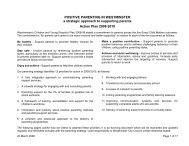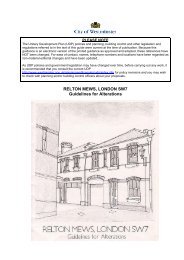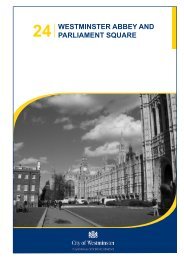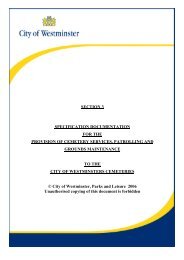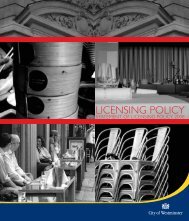Westminster Open Spaces Noise Study 2008 Final Report
Westminster Open Spaces Noise Study 2008 Final Report
Westminster Open Spaces Noise Study 2008 Final Report
- No tags were found...
Create successful ePaper yourself
Turn your PDF publications into a flip-book with our unique Google optimized e-Paper software.
<strong>Westminster</strong> <strong>Open</strong> <strong>Spaces</strong> <strong>Noise</strong><strong>Study</strong> <strong>2008</strong>: <strong>Final</strong> <strong>Report</strong>3.3.4 The assessment of sites using the toolkit method is explained below as a step-by-stepprocess in ‘3 Using the toolkit’. Poorly performing spaces i.e., those that achieve a lowscore in the assessment described below, can be improved by implementing suitablemeasures to eliminate negative scores or to gain positive scores depending on costs, timeetc.3.4 Limitations of the Method3.4.1 Several experiential indicators listed separately in the questionnaire are quite similar toeach other. For the purposes of the research, they were kept distinct in order to tease outfine differences of perception. For less busy open spaces, it may be helpful to combineindicators in the list for analysis and to reserve the questionnaire (Appendix B) for siteswhere high response volumes are anticipated. For example, the factors ‘green landscape’and ‘grassy surfaces’ can be combined.3.4.2 Using the Likert scale, some sites may achieve relatively neutral scores, i.e., tendingtowards neither positive nor negative, even though some individual indicators may havehigh positives or negatives. In such cases, individual factors need investigation, and tohighlight this, total positive and negative scores have been kept, as well as the netTranquillity Score.3.4.3 The Civic Paved Space typology has only one site within it and may, therefore be lessrobust in its toolkit weighting than the other typologies. Further surveying at TrafalgarSquare, or assessment of additional similar sites, is required in order to ensure thedependability of this particular weighting.3.4.4 This methodology does not account for:• The ‘culture’ of place to any great extent, except to consider ‘high profile’ Londonspaces – this needs more time and space for a finer analysis;• Changes in usage patterns due to weather conditions, except to exclude interviewsessions and noise measurements carried out in bad weather; and• Personal mood – the toolkit has not been able to assess scores over time againstusers’ mood. Although this is outside the scope of this study, a quantitative measureof ‘happiness’, such as measuring users’ blood pressure changes would beparticularly significant from a health and well-being perspective.D121316/R1/0213Scott Wilson LtdMarch 2009





